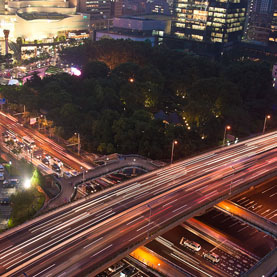Without a strong scientific foundation, urban design theory may find itself extinct within the coming decades
By Sarah Fecht
In 1961 urbanist Jane Jacobs didn’t pull any punches when she called city planning a pseudoscience. “Years of learning and a plethora of subtle and complicated dogma have arisen on a foundation of nonsense,” she wrote in The Death and Life of Great American Cities. Fifty years later the field is still plagued by unscientific thought, according to urban theorist Stephen Marshall of University College London. In a recent paper in Urban Design International, Marshall restated Jacobs’s observation that urban design theory is pseudoscientific and called for a more scientific framework for the field.
Although urban design theory is unscientific, Marshall wrote, it is not because the ideas are based on nonsense—many of the classic urban thinkers used observations and small pilot studies to describe how cities work. Jane Jacobs, for example, proposed that a city needs four ingredients to be exuberant: mixed uses, short blocks, buildings that vary in age and condition, and a dense concentration of people. “At the core of this book is a four-part hypothesis that is demanding to be tested,” Marshall says. “But when I went to look to see if it had been tested, there was virtually nothing.” The problem with urban design, he adds, is that its theories are untested, yet accepted as fact. Marshall proposes to overhaul the way that urban design incorporates science into its fabric, calling for more and better urban science, and for the theories to be challenged with alternative hypotheses and rigorously tested.
Some researchers are already studying cities in scientifically valid ways, but much of this work is being done by physicists and mathematicians who have little use for urban design theory.
“In urban planning, we’re like physicists without a particle theory or doctors without a germ theory,” says Michael Mehaffy, an urban designer at Portland, Ore.–based design company Structura Naturalis. “We don’t have a unifying idea about the nature of what we’re looking on. We say we’re artists but it’s as if we’re medieval doctors with potions…. We need to recognize that we have a responsibility to use models that are more likely to produce better outcomes.”
Urban designers traditionally have doubted the role that science can play in describing or predicting or fixing a city. They assert that cities have an emergent complexity that results from the interactions among people as well as between people and the environment, and that there is an element of human behavior that cannot be reduced to an equation. “I’m not really sure that the city can be studied and predicted any better than we can predict the weather,” says Peter Laurence, an architect at Clemson University. “And cities are more complex than the weather.”
Geoffrey West, a physicist at the Santa Fe Institute who studies urban growth, agrees. People who study cities “are dealing with maybe one of the most complex systems in the universe,” he says. “The idea that you could reduce it to an equation is extremely hubristic.” Yet he and others are using computer simulations, modeling and mathematics to begin to tease out the simple rules that give rise to urban complexity and diversity. For example, West has devised formulas that use a city’s population to predict the size of the metro police force, the number of people with AIDs and the annual tonnage of carbon dioxide emissions. The predictions are accurate 85 percent of the time. That consistency is guided by universal social dynamics that govern the way people interact with each other and with the environment, West says. The other 15 percent is individual variation between cities.
Although West says he’d like to see urban design’s classic theories put to the test and integrated into a scientific framework, he finds his own scientific work as complementary to traditional ways of studying cities. “The thing that makes urban planning so difficult is that the role of design has to be there. That’s critical, and it involves things that are outside of science in the traditional sense.”
How can these two viewpoints—of science and design—be reconciled? Mehaffy suggests that urban design theory and urban design practice could have a relationship like that of life science research and medicine. A doctor doesn’t spend all of his time in a research lab, but he relies on scientific knowledge to guide his decisions on a case-by-case basis. The art comes in the form of tailoring diagnoses and prescriptions for each individual patient.
Marshall says that if urban designers don’t build themselves a more scientific foundation, then outside researchers will do it for them. To survive, the field needs to incorporate scientific training into its educational curricula, and cultivate “a concern for testing and validation, critical assimilation of scientific findings from disparate sources, and dissemination of the most reliable, up-to-date findings.”
Will the next 50 years be any different from the decades that have passed since Jane Jacobs first cast urban design into pseudoscientific limbo? West thinks that as cities grow and researchers continue to elucidate the influence of design on factors such as carbon dioxide emissions, physical activity and quality of life, there will be an inevitable shift toward scientific thinking. “The city is most important problem we have to face,” he says. “What are the underlying principles of urbanization, and what is urbanization going to do to the planet?”
http://www.scientificamerican.com/article.cfm?id=urban-legend-can-city-planning-shed-its-pseudoscientific-stigma&goback=%2Egde_69691_member_194784816

Speak Your Mind
You must be logged in to post a comment.